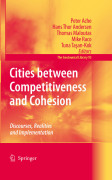
Cities between competitiveness and cohesion: discourses, realities and implementation
The central aim of many analyses in population studies and demography is to explain cause-effect relationships among variables or events. For decades, population scientists have concentrated their efforts on estimating the “causes ofeffects” (e.g. What accounts for the decline of fertility rates?) by applyingstandard cross-sectional and dynamic regression techniques, with regression coefficients routinely being understood as estimates of causal effects. The standard approach to infer the “effects of causes” (e.g. What is the effect of women’s labour force participation on fertility?) in natural sciences and in psychology is to conduct randomised experiments. In population studies, experimental designs are unfeasible. Nevertheless, quasi or natural experiments are sometimes performed to estimate treatment effects. However, most research is based on non-experimental designs (also called observational or survey designs). Inferring the effects of causes - or treatment effects - from other than experimental data is tricky. However, treatment effects can be inferred from non-experimental data with a counterfactual approach. In such a perspective, causal effects are defined as the difference between the potential outcome irrespective of whether or not an individual received a certain treatment (or experienceda certain cause). The counterfactual approach to estimate effects of causes from quasi-experimental data or from observational studies was first proposed by Rubin (1974). Other important contributions include the work of James Heckman and collaborators and of Charles Manski and collaborators.
- ISBN: 978-1-4020-8240-5
- Editorial: Springer
- Encuadernacion: Cartoné
- Páginas: 299
- Fecha Publicación: 01/05/2008
- Nº Volúmenes: 1
- Idioma: Inglés
